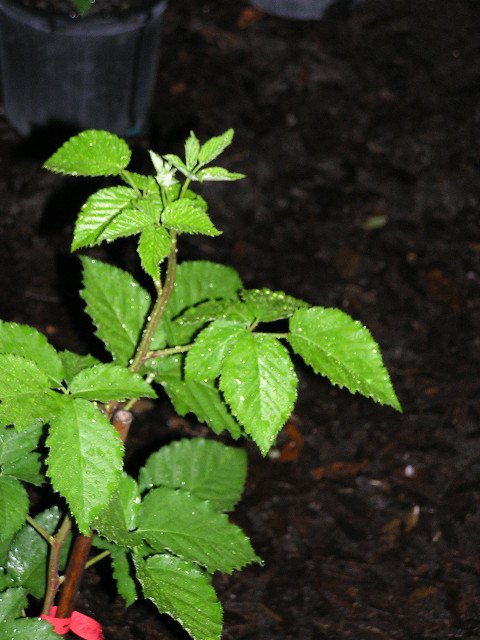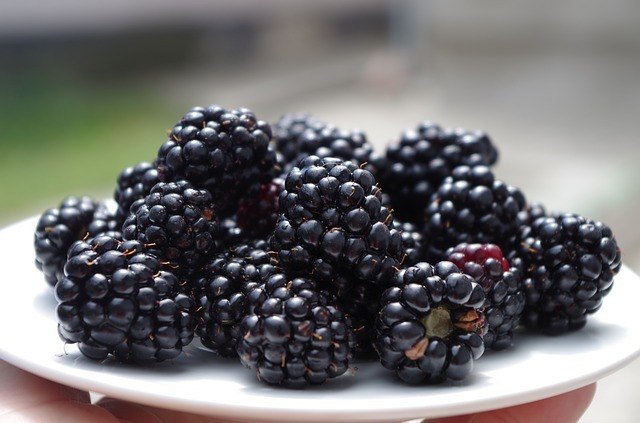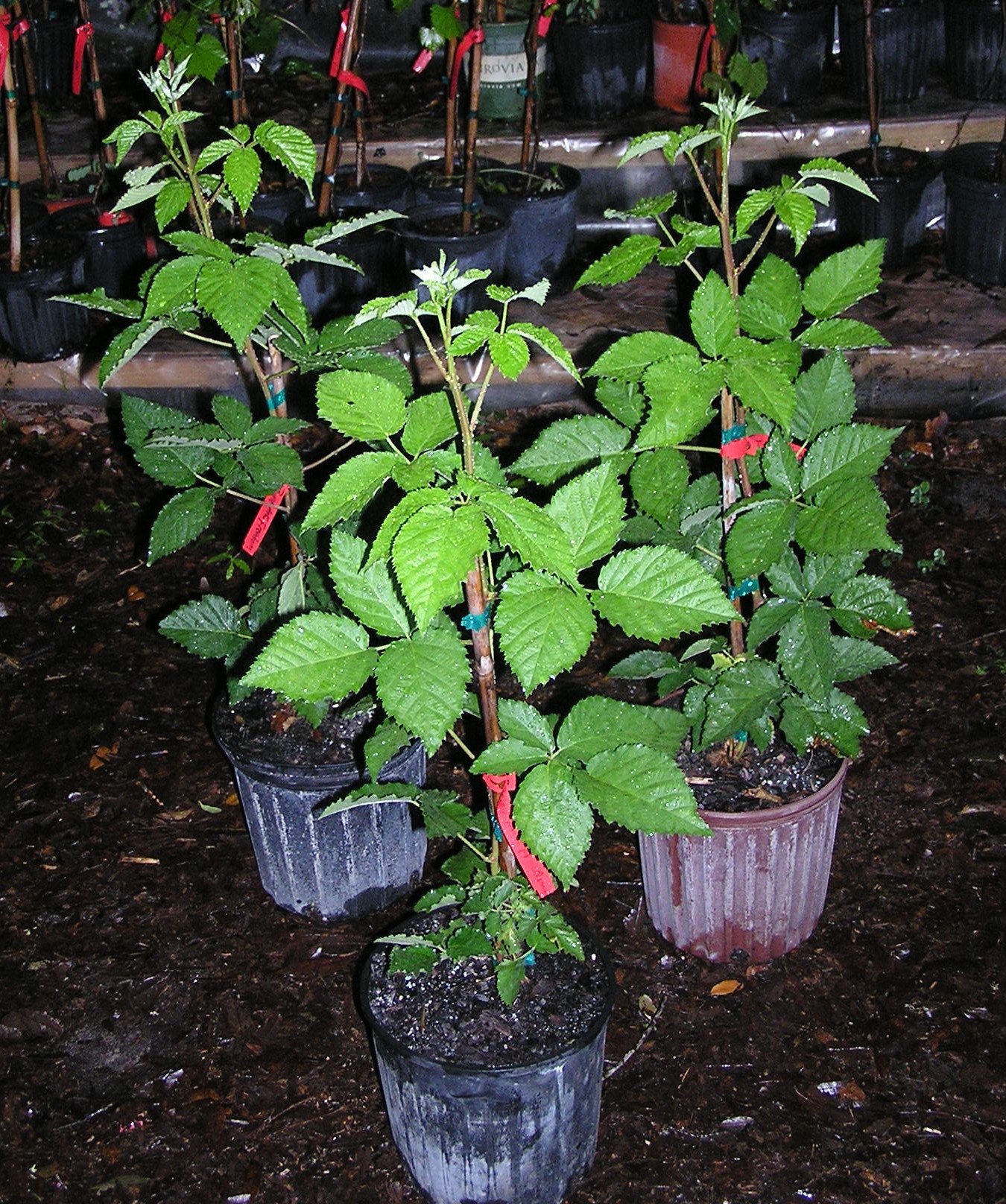Low Chill Thornless Blackberries for the Coastal SE & Florida
Rubus fruticosus aggregate
hardy in zones 5-10
Blackberries are a perennial, some growing to 10' high and up to 10' wide when mature if they have room and plenty of nutrition. They require full sun to partial shade. And while the plant lives from year to year, they will lose their leaves in the cold of winter.
Low chill thornless blackberries are far easier to harvest from than their thorny wild cousins. New 'primocane' varieties from U of AR provide high yields on first year canes. Initial plantings appear to be more vigorous than previous 'floricane' selections and may prove more hardy and prolific for Florida.
Planting a second variety for cross pollination helps to increase yields.

Blackberries on the vine
Blackberries can be either semi-erect cane plants or trailing types. The thornless cultivars are mostly considered semi-erect cane types, but some still benefit from a sturdy trellis for support. For example, Navajo needs no support but Natchez is clearly a trailing vine.
growing conditions
Blackberries can be easy to grow if you get their micro climate right.
They prefer rich soil with plenty of organic matter, good air circulation and good water drainage. Optimal soil pH is 6.0 to 7.0, but blackberries can adapt well to most any kind of soil pH. Plant at least 2' apart, though more like 6-8' will give room to mature plus extra room for air circulation.
Do not select a site where potatoes, tomatoes, peppers, eggplant, other caneberries, or strawberries have been grown within the past 3 years. Avoid planting where vegetables have been grown the previous year.
Plant far away from any existing raspberry plants too. The reason is blackberries and raspberries can both be susceptible to verticillium wilt, a fungi associated with those plants. So the idea of keeping them separate is to avoid spreading the disease if one or the other gets it.
If you use mulch, choose something like sawdust or hay, so that you don't encourage fungi to grow under the plants. Eucalyptus mulch would also be an excellent choice.
primocanes vs floricanes
Blackberry and raspberry plants are naturally biennial, meaning each cane only grows for two years and then dies. First year growth is called primocanes. Two year old canes are called floricanes.
Most varieties are classed as floricanes because they only fruit on 2-yr-old growth. But some new selections developed by the University of Arkansas are primocanes, and will develop fruit on both kinds of canes as they age, depending on how you choose to prune.
Floricanes will produce a summer crop, starting in mid July in Florida, while the primocanes will produce a fall crop beginning in late August and continuing until frost. How you prune will determine what months you harvest fruits.
pruning
Trim canes to encourage new growth and you'll have higher yields.
On floricane varieties, fruit only forms on 2 yr old canes, and then those canes die at the end of the season. So trim the older canes at ground level after harvesting fruit, so that new canes will shoot right away while the weather is still warm enough for new growth. New canes will also shoot up from the roots, making a bushier plant.
On primocane varieties, new canes will bear fruit in the early fall through the first frost, giving you an extended harvest into November. Older floricane stems (2 yr old growth on either floricanes or primocanes) can start bearing in mid-summer, though tests show that fruit is sweeter on the fall harvests than the summer harvests. For that reason, some growers choose the 'mow it down' method of pruning primocanes: they mow the entire row in late fall and let the plants re-grow for spring!
On primocane varieties, you can pinch the tips on new growth in the late spring to encourage a more bountiful harvest, but it will delay the crop till later in the fall if you do. So tip pruning is best for zones 8-10, and not as useful in zones 6-7 because of early frosts.

blackberries can ripen from July-Nov in FL

Prime Ark Freedom blackberries are vigorous
4 robust varieties for the deep south:
CULTIVARS
Just like with peach trees, if you choose multiple cultivars to plant, you can extend your harvest season. It is possible to harvest from July to even November. The following are all thornless blackberries that work well in zones 8 & 9:

delicious berry snack!
navajo
Navajo is a mid season blackberry (late July to August) for zones 6a-10b with exceptional flavor. I would go so far as to say it may be the number one floricane blackberry to plant in this area because of flavor, production and especially ease of care of a bush-shaped plant. Plants average 4-5' high and wide and are highly resistant to disease.
At 11-12% sweetness, Navajo blackberries are one of the sweetest thornless blackberries compared to 9-10% on most of the other cultivars. And while sources say it needs 800-900 chill hours for optimum fruiting, it thrives and fruits very well in all of zone 9 in Florida where the chill hours range from 300-650.
Navaho ripens over a long period of about 5-6 weeks, and produces berries up to 1" in length. It's seeds are so small that some vendors have called it "seedless". It was a 1989 patented variety from the University of Arkansas.
arapaho
Araphaho is one of the earliest fruiting varieties in FL: about 10 days earlier than Navaho, from mid July to August.
Arapaho is a 1993 release from U of AR breeding program. It was the first semi-erect thornless blackberry to be developed.
Plants are strong upright growing, highly heat and humidity tolerant, and consistent producers.
Berries are medium to medium-large in size, quite firm with very small seeds, and sweet with excellent flavor.
Hardiness zones 5b-10
ouachita
Ouachita is another early to mid-season blackberry, with a longer ripening season than Natchez: about 5 weeks.
Vigorous, upright thornless canes attain an average size of 3-4' height and width, but still benefit from a trellis.
It is a heavy producer of very sweet berries: Soluble sugar content is similiar to Navajo at 10-11%.
At 300-400 chill hours for maximum productivity, Quachita is one of the lowest chill hour thornless blackberries. A University of Arkansas patented release from 2003.
prime ark freedom
Prime Ark Freedom is an exciting new release from the U of AR (2013). It is the first thornless primocane selection, which means colder areas of the US (zones 3-5) can now grow thornless blackberries without overwintering protection, mowing the tops off at the end of the season as a means of pruning.
It is recommended for zones 3-9 until tested further south. Vigorous growing plants are highly disease resistant with a high tolerance for heat and humidity, making them a great choice for most of FL. They are self-fertile, but like most blackberries will benefit from a second variety nearby.
In zones 8-9, we can expect 2 crops: a summer crop in mid July from the 2yr old canes (called floricanes), and a fall crop from the current year's growth, the primocanes.
Berries are consistently very large (9-16g), quite sweet (10.4% sugars), and very good flavor. The primocane crop ripens late August to Nov.
Good for zones 6-9 for floricane production, and zones 3-9 for primocane production.

2g Prime Ark Freedom
What's in stock for 2023:
2yr old Navaho blackberry bushes
3g / $25ea or 2 for $40
2yr old Baby Cakes®: 7g/$35

2g blackberries
